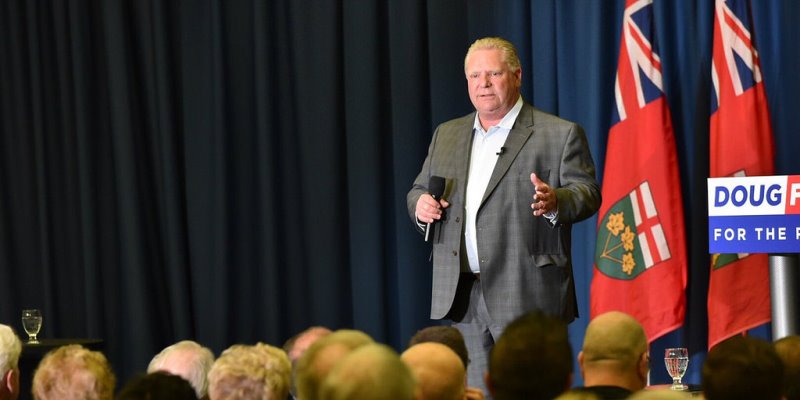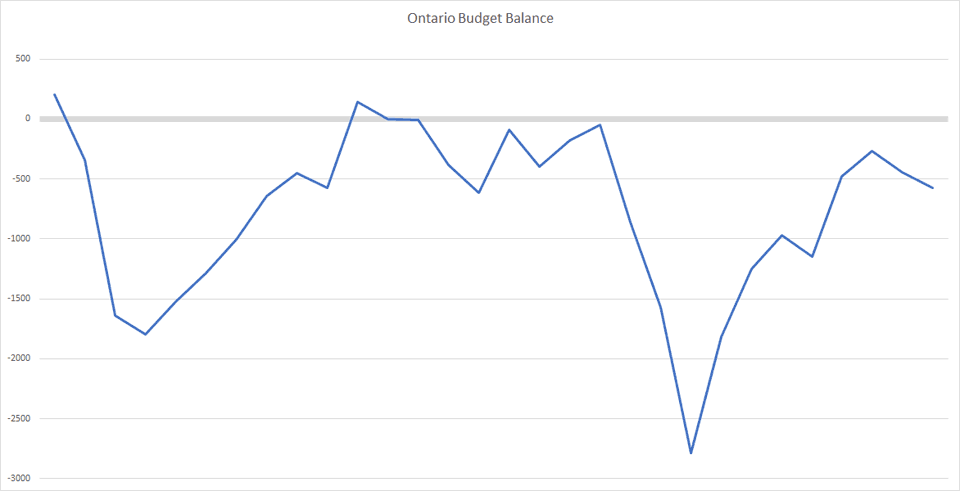With right approach, Ford government can stop Ontario’s fiscal roller-coaster

Followers of Alberta government finances are used to hearing term “roller-coaster.” The analogy is that government revenues quickly rise when natural resource royalties go up, and then often plunge when they go back down.
Often, Alberta’s government fiscal balance (surplus or deficits) also behaves like a rollercoaster, rising and falling quickly. There are exceptions—the Klein government used spending reductions to eliminate a large deficit and balanced the budget in the 1990s without much help from rising resource royalties. But generally, the analogy is apt and in fact used so often it has become a cliché.
What is perhaps less well-known is that Ontario has been on a fiscal roller-coaster ride of its own over the past 30 years. The chart below tells the tale.

In 1990, Ontario’s budget was balanced. Back then, Ontario’s debt-to-GDP ratio (a good measure of a province’s ability to pay back its debt) was just 13.4 per cent. Then the roller-coaster took its first plunge. In 1991, a severe recession hit Ontario. Due to a combination of reduced revenue from the recession and increased government spending intended to reduce its severity, the deficit quickly climbed to more than $1,500 per person (all figures inflation-adjusted to 2019 dollars).
After that, the deficit shrank over time—but as is the case with roller-coasters, the trip up was a lot slower than the fall down. As a result, Ontario ran a long string of budget deficits, with net debt steadily climbing and reaching a 1990s peak of 32.3 per cent.
Then the roller-coaster levelled off for a while. Ontario ran deficits most years in the early and mid-2000s, but much smaller than preceding years. Certainly, the province did not run substantial primary surpluses that would have helped cancel the effect of the 1990s debt binge. And so the debt-to-GDP ratio stayed more or less where it was.
Then in 2008, the roller-coaster took another fast trip downward. Deficits surged from almost zero in 2008 to $2,784 per person in 2011—even higher than the ’90s peak. Once again, the slow pace of improvement after the recession meant the province racked up debt year after year. During this time, Ontario never actually got all the way back up to balance and the province’s net debt-to-GDP ratio surged to 39.7 per cent.
Now, with the COVID shock, Ontario’s fiscal roller-coaster has started yet another rapid decline. The Ford government’s recent budget showed big deficits over the next three years and a rapid increase to the province’s debt-to-GDP ratio.
So as Ontario’s fiscal roller-coaster plunges back down again, what lessons can we draw from the last two descents and slow climbs back up?
First, it’s important to recognize that the vast majority of debt accumulation that occurred the last two times did not occur during the recessions themselves, but in the years afterwards. If the Ford government wishes to avoid the same fate as its predecessors—of seeing the province’s debt burden climb rapidly and consistently on its watch—it must find a way to shrink the deficit at a pace more similar to what we saw following the last two recessions.
Accomplishing this objective won’t be easy but the Ford government can maximize its chances by carefully monitoring the state of the economy and public health challenges, and winding down emergency spending as fast as possible. There’s considerable contingency room included in the 2020 budget; extra budget space beyond solid spending commitments that the government can use if necessary. Wherever there are possibilities to leave that contingency space unused without jeopardizing public health or economic recovery, the Ford government should pocket the savings.
Once the crisis is over, if slowing debt accumulation without hindering economic growth is a Ford government priority, it must conduct a thorough review of all expenditures and find room for savings. Again, this won’t be easy. But it’s the best option for shrinking the budget deficit while giving the economy its best shot at a strong recovery. Research from late Harvard economist Alberto Alesina (and co-authors) examined deficit-elimination efforts across economically developed countries and found that spending reductions tend to do far less harm to the economy than tax increases.
One place the Ford government can look to save money is on the government wage bill. Recent research shows that government employees in Ontario make (on average) 10.3 per cent higher wages than similar workers in the private sector, along with more generous non-wage benefits.
This research examined all government employees (federal, provincial and local) but it strongly suggests that provincial government-sector workers enjoy a compensation premium over similar private-sector workers. Shrinking this gap may produce significant savings because wages and salaries of government employees consume a big share of Alberta’s budget.
When it comes to provincial government finances, Albertans are already familiar with the roller-coaster analogy. But the analogy also applies to Ontario’s books over the past three decades. Now with another recession upon us, a key question looms large. Will the Ford government succeed where its predecessors failed, and shrink the deficits quickly when the recession ends and help prevent the accumulation of more debt on an already debt-laden province?

